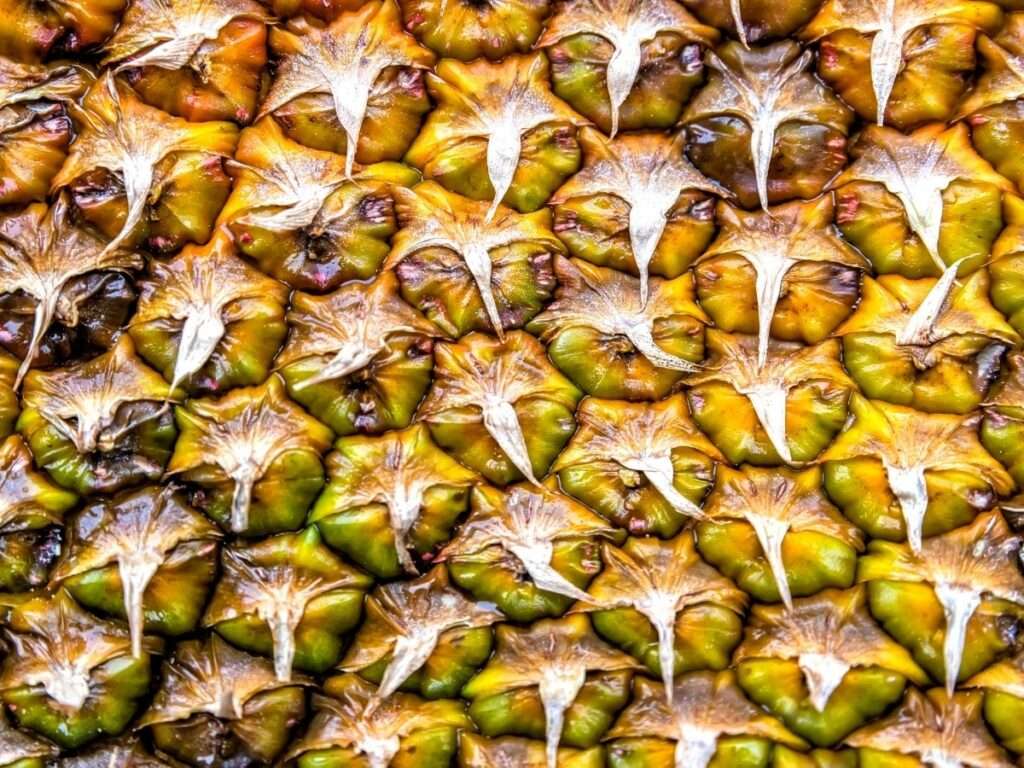The pineapple has a rich history in American culture and pineapple decor has become known as a symbol of hospitality and influence.
Shaped like a giant pinecone with a large crown of densely packed leaves, the pineapple immediately commands attention. While it once represented unattainable wealth, this delicious and dramatic fruit now represents warmth, welcoming smiles, and hospitality.
This tradition dates back to the American colonists in the 17th century, who began importing the pineapple from the Caribbean. Back then, obtaining a fresh, ripe pineapple was not nearly as easy as it is today. You couldn’t pop over to the local grocery store and pick one up.
Therefore, the pineapple was seen as being very exotic and rare. That’s why any host who was able to serve pineapple to their guests was seen as being of great wealth and influence. And thus began the auspicious beginnings of the now-humble pineapple.
How Did the Pineapple Get Its Name?

It seems kind of obvious if you think about it. This strange fruit looks like an oversized pinecone, until you cut it open and find the ripe, sweet pulpy center.
It is believed that it was Columbus, on his voyage to the Caribbean In 1493, who found the fruit on the island of Guadaloupe. To the European eye, this curious new fruit had an abrasive, segmented exterior like a pinecone and inside the fruit had a firm interior pulp like an apple. The first official record on this delightful fruit came from Michael de Cuneo, a childhood friend of Columbus and his voyage companion
The plant looks like an artichoke… the fruit is shaped like a pine cone, only twice as large and it tastes excellent. It can be cut with a knife, like a turnip and it seems to be very healthy.
Michael de Cuneo
It does seem like a simple explanation that the combination of the pinecone like exterior and the sweet interior spurred this unique name.
However, linguistic experts tie the name even further back in linguistic history. According to Merriam-Webster, about a century before Columbus’ travels, the word pineapple was typically used to describe what we now know as a pinecone. Pinecone didn’t come into the modern vocabulary until around the middle of the 16th century.
Along with that, almost any kind of foreign fruit, as well as some nuts and vegetables, were initially given an “apple” name. For example, the pomegranate was named pōmum grānātum, which translates to “an apple with many seeds.” The eggplant was known as the “love apple” (and – in the emoji world – it is somewhat known as that once again).
So, if you combine the fact that “apple” was almost automatically given to any kind of foreign fruit, and “pineapple” had been – in years past – used to describe pinecones, it does make sense that this pinecone/apple combination would take over that name.
One other interesting fact. Ananas is the official name for the plant genus and is used in many languages today for the pineapple. But, in case you were wondering, it is completely unrelated to bananas. However, bananas do share something in common with the pineapple as well as the pinecone – at one point in history, they were all referred to as an apple.
The Pineapple as a Symbol of Prosperity

Soon after its discovery, the fruit quickly became highly sought-after by royalty purely because of its scarcity and stately appearance. Europe’s royal houses were known to have paid the equivalent of about $7,000 – $8,000 in today’s dollars for a single pineapple that they could put on display as the centerpiece at their dinner tables. In fact, King Charles II of England even commissioned a portrait of himself receiving a pineapple as a gift. The pineapple quickly became the ultimate symbol of royal superiority and became known as the “King of Fruit”.
Part of the reason for the high cost was that the fruit simply did not survive the long, hot journey across the ocean. Entire shipments would often rot before they could complete the journey and be sold to the highest bidder.
However, these industrious merchant sea captains knew that they had to figure out new ways to preserve the fruit in order to capitalize upon its demand. Eventually, they discovered that when pineapple was packed with sugar, it was able to last longer and survive the journey in greater quantities.
Although this did help reduce the scarcity – and the price tag – the pineapple was still a very expensive acquisition. Only the very wealthy could afford to serve pineapple desserts to their guests. In fact, those who could not afford to obtain the fruit would sometimes rent one for the day, just to pretend that they were more affluent than they really were.
Another cost-saving measure was to utilize bits of pineapple that had been candied in sorbets, ice cream, or as a garnish on another type of fruit dish or dessert.
Pineapples became a must-have centerpiece at extravagant banquets. If you wanted to show off your immense wealth and power, you did so by including pineapple in the meal.

Fun Fact
A pineapple’s scaly skin grows in a natural Fibonacci sequence, which is a series of numbers where each consecutive number is found by adding the two previous numbers together.
Fibonacci numbers seem to come up often in nature, and the pineapple is no exception.
This symbol of influence and hospitality continued to grow, and the pineapple began to be used to decorate bedposts, China patterns, napkins, tablecloths, and anything else that was associated with entertaining fine guests. In many grand homes throughout England and France, pineapple wallpaper or pineapple stencils covered the walls of elegant manor houses. The pineapple was no longer just a delicacy but had become an intrinsic part of elegant decor.
In fact, I’m pretty sure I spotted at least a few pineapple decor elements gracing the halls of Downton Abbey.
Eventually, the pineapple became an architectural feature on the outside and throughout the home, often carved into fine wood as an enduring symbol of prosperity.
The Pineapple as a Symbol of Welcome & Hospitality

As Europeans began to settle in America during the early 18th century, they brought with them the tradition of the pineapple as a way to showcase their wealth and aristocracy. Wealthy landowners, many of whom settled in the Southern colonies, embraced the symbol of the pineapple during dinner parties and in their home’s construction and decor.
As time went on, and the pineapple started becoming more readily available, it inherited some additional symbolism that was more relatable to the common folk. For example, it is believed that using pineapples in the architectural details outside of a home was first introduced in Europe by travelers returning from the New World who had seen pineapples hung outside the entrances to Caribbean villages. Because they were so warmly greeted by the native people, they believed the pineapple to be a sign of welcome.
Others tell stories of how a pineapple would be placed outside the home of a sea captain to alert townsfolk of his safe return from the tropics. The pineapple was seen as an invitation by the sea captain and his family to stop by for refreshments and hear tales of his time at sea.
Over time, the pineapple stopped being a frivolous exhibit of wealth possessed by only the elite. Instead, it became become an accessible symbol of neighborliness and hospitality. That tradition continues today and the pineapple remains a warm and welcoming symbol to any visitor who happens to drop by. This is why you often see elements of pineapple decor in the home and gardens of the most hospitable hosts.
Pineapple Decor for Your Home
If you are looking to add a touch of symbolic decor that is rich in history, we have curated some lovely pieces that will do just that!
Sweeter Than Candy, Richer Than Gold

So, if you are ever able to invent a time machine – forget about collecting gold and jewels to use as currency. Scoop up a couple of bags of pineapples from the local grocery store and you can live like a king!





